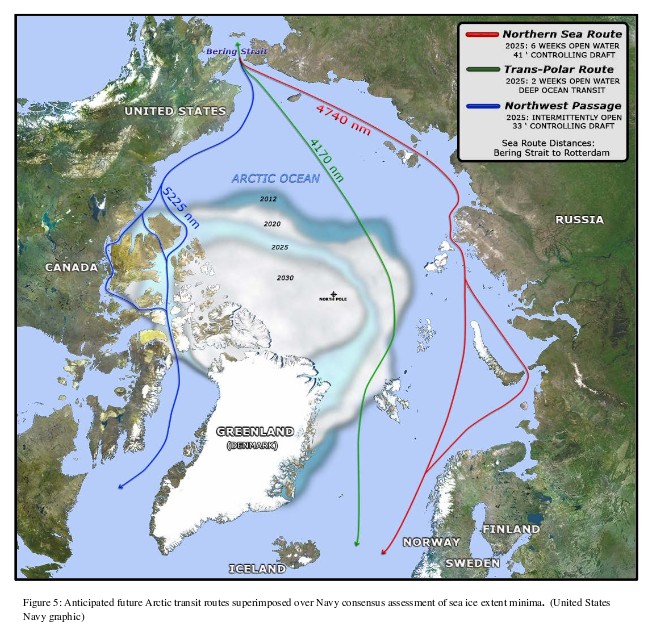March 24, 2014
US Navy 2014 to 2030 Arctic Roadmap
The US Navy recently released their new "Arctic Roadmap" for the years 2014 to 2030. According to the Navy's press release:
In the coming decades, as multi-year sea ice in the Arctic Ocean recedes, previously unreachable areas may open for maritime use for a few weeks each year. This opening maritime frontier has important national security implications and impact required future Navy capabilities.
"Our goal is to have the Arctic continue to unfold peaceably," said Vice Admiral Michelle Howard, Deputy CNO for Operations, Plans and Policy. "Working with our maritime and inter-agency partners, and by investing smartly in future capabilities, we can contribute to a secure and stable Arctic region."
"As the perennial ice melts and open water is available for longer periods of time, we are committed to expanding our Arctic capabilities," said Rear Admiral Jonathan White, Oceanographer of the Navy and the Navy's Task Force Climate Change director.
Given the vast distances and virtually no supporting infrastructure there, naval forces without specialized equipment and operational experience face substantial impediments. Naval operations in the Arctic Ocean require special training, extreme cold-weather modifications for systems and equipment, and complex logistics support.
Amongst many other things the roadmap document itself discusses future reductions in sea ice cover in the Arctic:
Reduction of Arctic Ocean sea ice is expected to continue, and major waterways will become increasingly open. By 2020, the Bering Strait is expected to see open water conditions up to 160 days per year, with 35-45 days of shoulder season. The Northern Sea Route will experience up to 30 days of open water conditions, with up to 45 days of shoulder season conditions. Analysis suggests that the reliable navigability of other routes, including the Transpolar Route and the Northwest Passage, is limited in this timeframe. There will be shoulder season route variability based upon ice age, melt, and movement.
By 2025, the Bering Strait will see up to 175 days of open water (and 50-60 days of shoulder season). These figures increase to 190 days of open water (and up to 70 days of shoulder season) by 2030. For the Northern Sea Route, predictions are for up to 45 days of open water (with 50-60 days of shoulder season) by 2025, increasing to 50-60 days of open water by 2030 (with up to 35 days of shoulder season conditions). This period will begin to see greater accessibility of the Transpolar Route, which is forecast to be open for up to 45 days annually, with 60-70 days of shoulder season. Analysis suggests the reliable navigability of the Northwest Passage will continue to remain limited in this timeframe.
Beyond 2030 environmental conditions are expected to support even greater and more reliable maritime presence in the region. Major waterways are predicted to be consistently open, with a significant increase in traffic over the summer months. The Northern Sea Route and Transpolar Route should be navigable 130 days per year, with open water passage up to 75 days per year. The Northwest Passage will be increasingly open during the late summer and early fall.
Here is the US Navy's graphic representation of how the sea ice will recede and commercial shipping will increase in the Arctic over the next 15 years or so:
 Summarising matters, the Roadmap's introduction concludes that:
Summarising matters, the Roadmap's introduction concludes that:
Anticipating the impacts of climate change, the Navy will take deliberate steps to prepare for near-term (2014-2020), mid-term (2020-2030), and far-term (beyond 2030) Arctic Ocean operations. As security conditions change and the Arctic Region becomes more accessible, the Navy will re-evaluate its preparedness. The Navy must make targeted investments in Arctic capabilities to hedge against uncertainty and safeguard enduring national interests.
Filed under Politics by
Leave a Comment